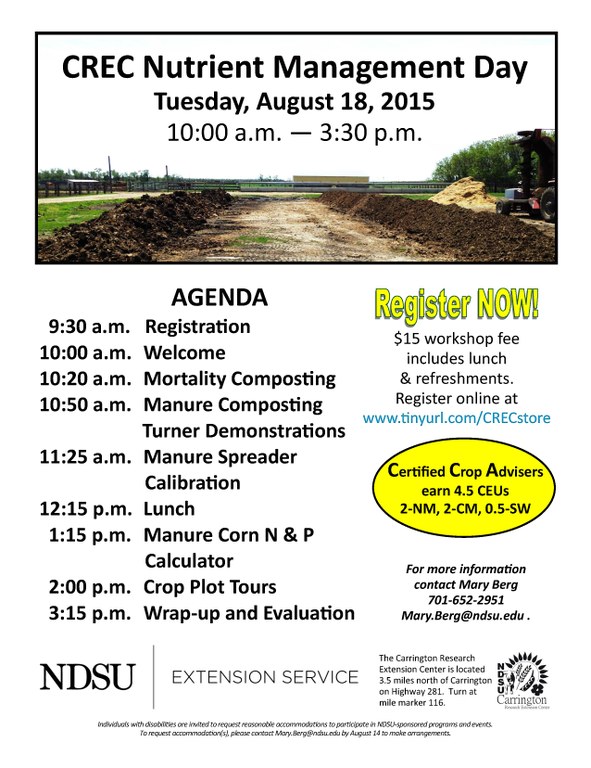2015
Nutrient Content in Solid Feedlot Beef Manure Across North Dakota
As small grains start coming off the fields and bins start to fill, it’s time to plan fall fertilizer applications for next year’s crops. This time of the year coincides with feedlot pen clean up, when considerable amounts of manure might become available for land application. It is well documented that beef manure contains many essential micro and macronutrients for plant development and growth.
In North Dakota, 193 beef manure samples were recently collected and analyzed for nutrient content. In the table below, you will find a summary of those analysis results.
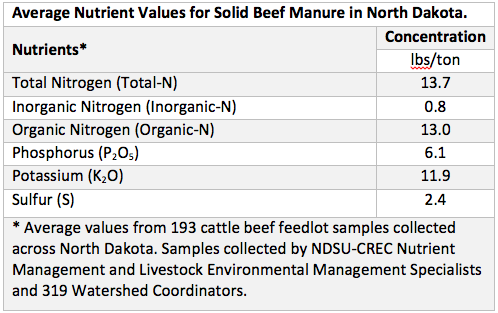
The values above are a good start for planning purposes, but it is strongly recommended to get your manure analyzed, so you know what nutrients you are really adding into the soil. Click on the following link to find out the manure testing laboratory closest to you: https://www.ag.ndsu.edu/lem/resources/manure-nutrient-sampling-and-testing. Many of them will ship you sampling containers and specific instructions upon request.
As you get ready to fertilize your fields (no matter the fertilizer source) keep in mind the 4Rs of nutrient stewardship:
- Right source: Match the fertilizer source with the crop needs.
- Right rate: Match the application rate with the crop nutrient requirements.
- Right time: Synchronize nutrient availability with crop demand.
- Right place: Place nutrient where crop can use them and where environmental concerns will be minimized.
More information on these concepts can be found here: http://www.nrcs.usda.gov/wps/portal/nrcs/detail/ia/home/?cid=nrcs142p2_008196.
Before purchasing commercial fertilizer this fall, consider contacting a beef operation near you to use manure as a fertilizer for the next growing season!
Want to learn more about managing manure as a fertilizer? Plan to attend Nutrient Management Day at the CREC on Tuesday, August 18th. Click on the poster below to register today!
Mary Berg
LEM Area Extension Specialist
Effects of whole or rolled corn and 20 or 40% forage levels on finishing performance of yearling steers
Objective: Investigate the effects of whole or rolled corn with 20 or 40% forage diets on yearling steers performance
Corn included in growing and finishing feedlot diets is typically processed by dry rolling, grinding, or steam flaking. The topic of how much processing and when to process is still debated. Forage level and moisture content of dietary ingredients, as well as other unknown factors may interact with the processing level and contribute to the variability in animal response. Our objective was to evaluate effects on animal performance and carcass characteristics from feeding whole or rolled corn in finishing diets with either 20% or 40% of the diet dry matter inclusion from grass hay.
One hundred and eight black crossbred yearling steers (917 ± 2.49 pounds initial body weight) were used to evaluate feeding whole or dry-rolled corn in diets with either 20 or 40% of the diet dry matter included from grass hay. Steers were randomly assigned to one of 12 pens (9 animals /pen) at the CREC. Each pen was randomly assigned to one of 4 treatment diets: 1) 55% whole corn with 20% grass hay; 2) 55% dry-rolled corn with 20% grass hay; 3) 35% whole corn with 40% grass hay; 4)35% dry-rolled corn with 40% grass hay; (Table 1).
Implications: There were no forage level by corn type interaction, indicating across each forage level (20% or 40%) when the same corn type (whole or rolled corn) was included in the diet it resulted in similar animal responses. Feeding diets with 40% forage as hay did impact final animal weights having lighter final weights than 20% forage at the same harvest end point. This was anticipated, due to lower energy value of the diet and was reflected by lower average daily gains with the 40% vs. 20% forage diets (Table 2). Thus the feed to gain ratio (pounds of feed required to gain a pound of body weight) was greater for the 40% vs. the 20% forage treatment. Whole or rolled corn resulted in similar weight, average daily gain and dry matter intakes. However there was a tendency for rolled corn to be more efficient as indicated by the lower feed to gain ratio.

Chanda Engel
Livestock Research Specialist
Leaf Cutter Bees
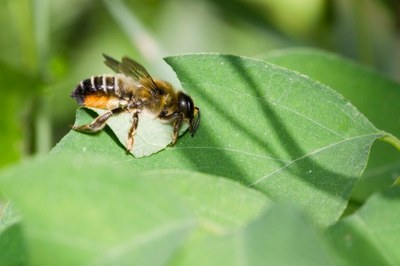
Surely by this time of year, you have seen the mysterious circular- or oval-shaped holes in the leaves of plants in your yard. These are formed by our friends, the common leafcutter bees. They are solitary bees in the large genus Megachile, in which there are almost 1,500 individual species.
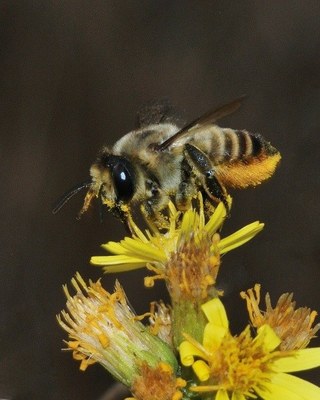
Leafcutter bees are smaller than honeybees. They don’t collect pollen on their legs like honeybees or bumblebees – they use hairs on their abdomen; if you see them, you might notice the bright yellow color of their tummies. I find the leaf holes now in summer but I’ve never managed to actually see the bees on flowers until fall. Leafcutter bees are super-productive pollinators. In greenhouse or netted experiments, USDA-ARS has shown that that 1 alfalfa leafcutter bee can do the job of 20 honey bees.
The bees nest in soft, rotting wood or in pithy stems like those of roses or elderberries– they will not damage your house. In spring, you could even set out elderberry or lily prunings for them to use as nests. They use those little leaf pieces to make individual cells for each egg in the nest. Leafcutter bees will use many kinds of leaves but prefer soft, smooth leaves such as those from: rose, green ash, lilac, and Virginia creeper.
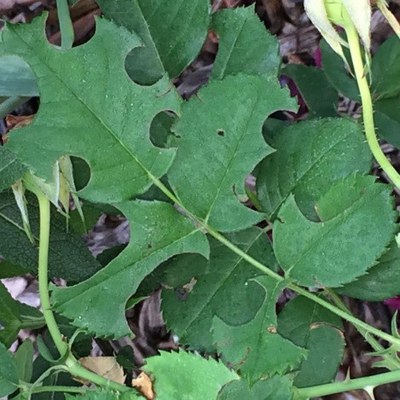
The leaf injury is usually just a curiosity. However, if you happen to live in a rural area with few leaf choices and abundant leafcutter bees, they could remove a lot of leaf tissue and hurt certain plants. Insecticides WON’T help since the bee is not eating the leaf; you will have to protect the plant with netting. It almost makes it tempting to leave more of those ash seedlings growing around the flower beds, doesn’t it?
Photo by K. Wiederholt, CREC.
References:
http://www.ext.colostate.edu/pubs/insect/05576.html
https://en.wikipedia.org/wiki/Megachile
http://www.ars.usda.gov/is/pr/1997/970820.htm
Kathy Wiederholt
Fruit Project Manager
Photo Review of the CREC Field Day
Last week on Tuesday, July 14 the CREC hosted its annual Field Day. We were fortunate to experience cooperating weather conditions with no rain to compromise the field tours and temperatures that were quite warm but very tolerable. More than 400 people participated in the CREC Field Day with all four morning tours very well attended. We appreciated the attendance of so many visitors since this event not only provide the opportunity to share CREC project activities but often results in interactions and new ideas for future projects. After the morning tours, the local Prairie Inn provided a noon meal that was enjoyed by all. For many participants the day’s events continued into the afternoon with an additional agronomy tour, other meetings and the continuation of the open house for the CREC’s new Agronomy Laboratory & Greenhouse. On behalf of all the staff of the CREC, we wish to thank all of you who traveled to the CREC to participate in this annual event. We hope you had a positive experience and were able to gain some information that will be useful in the future.
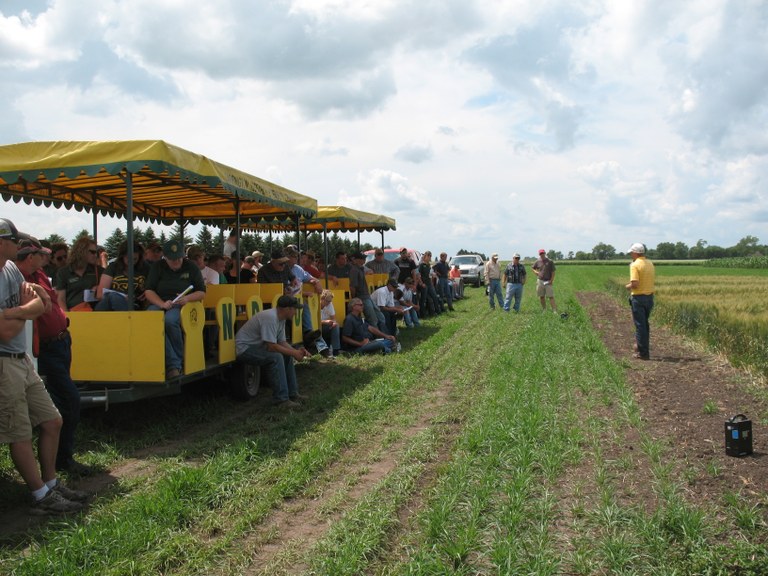
The agronomy tours had a great turnout this year. The morning tours covered plant variety topics for spring wheat, barley, durum, and dry beans, as well as basic production information for cool season pulses, corn, and soybeans. The afternoon tour was focused on precision agriculture, crop nutrition, herbicide-resistant weed management, and cereal and legume disease management. The tours went well and everyone had a good time. --- Mike Ostlie, CREC Research Agronomist
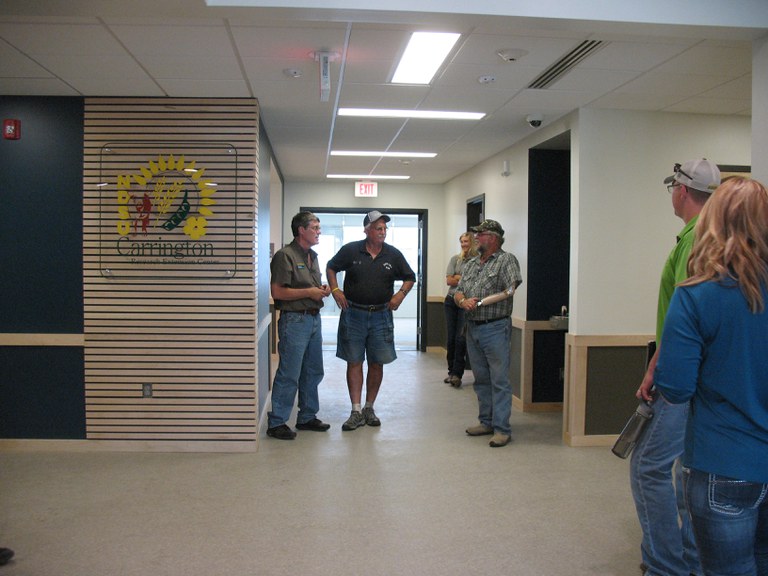
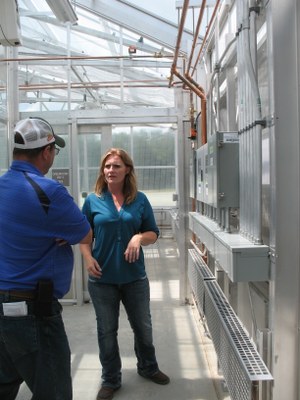
The timing of this year’s Field Day provided a great opportunity to have an open house for the CREC’s new Agronomy Laboratory & Greenhouse. Throughout the day field day visitors toured the laboratory and greenhouse. The facility was completed in late June and the research staff is really looking forward to utilizing the enhanced capabilities and capacity that is provided by this modern lab. The CREC wishes to thank the North Dakota Legislature for providing the funding for this facility which will allow our research teams to be even more productive in addressing the many challenges facing our producers. ---Blaine Schatz, CREC Director & Agronomist
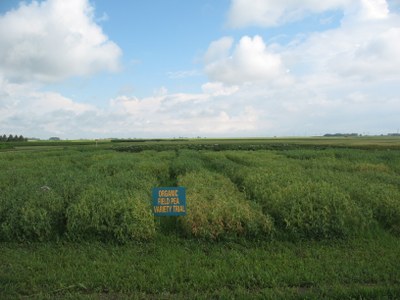
The CREC organic and sustainable ag program had a morning field tour that covered a number of topics from field peas, ancient grains, vegetables, oats, and fingerling potatoes, to cowpeas and radishes as cover crops. This was the fourth organic and sustainable ag tour held at the CREC and drew the largest crowd to date with approximately 75 attendees. The afternoon session included an indoor roundtable discussion to determine means to increase organic grain production in the Midwest to meet the increasing demand that is not keeping up with current supplies. The meeting was hosted by the US Organic Grain Collaboration, a group of national buyers, processors and distributers of organic grains, along with the Sustainable Food Lab. --- Steve Zwinger, Agronomy Research Specialist
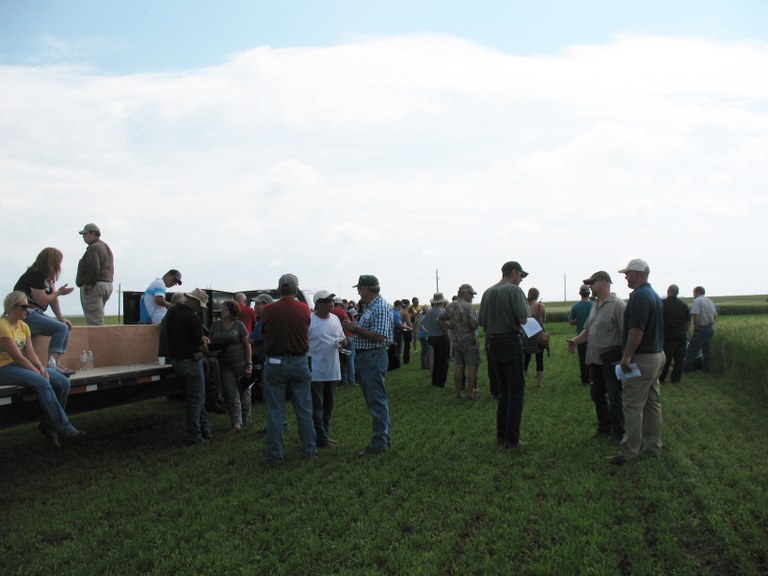
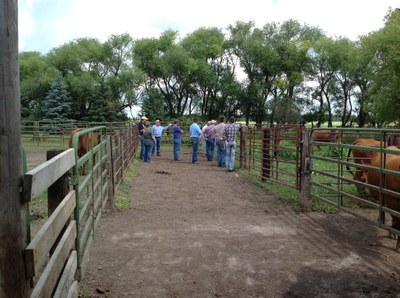
The CREC livestock program is a diverse program that includes cow-calf, weaned calf growing and cattle finishing research. The Livestock tour at the 2015 field day encompassed and showcased the diversity of the program. Researchers and guest presenters covered topics including alternative forage options for haying and grazing, producer feed-out program results and experiences, three recently completed feedlot nutrition projects, and drylot cow management research results and production economics. The event was capped off by 3 breakout session stations covering body condition scoring, matching feed to nutrient analysis, and a beef quality demo and taste testing experience. ---Chanda Engel, Livestock Research Specialist
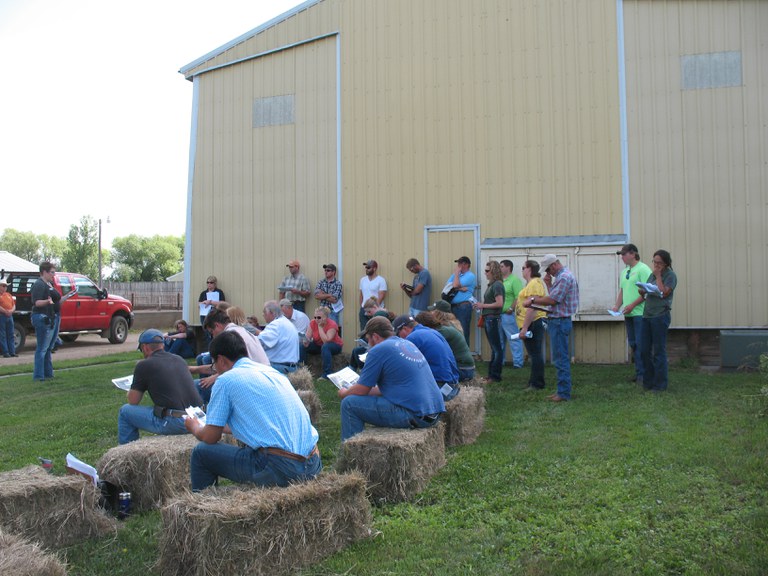
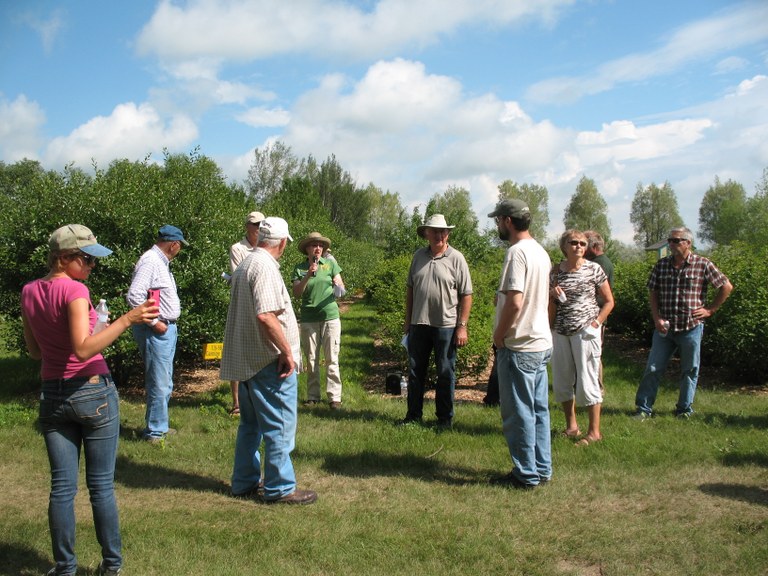
Approximately 70 people participated in the Fruit Project tour at the CREC Field Day. The focus of this year’s tour was black currants; a well-loved fruit in Europe. Participants tasted currants and Juneberries and especially liked the black currant jam. We visited and discussed our other crops, such as grapes, honeyberry, Juneberry, and aronia, too. ---Kathy Wiederholt, Fruit Project Manager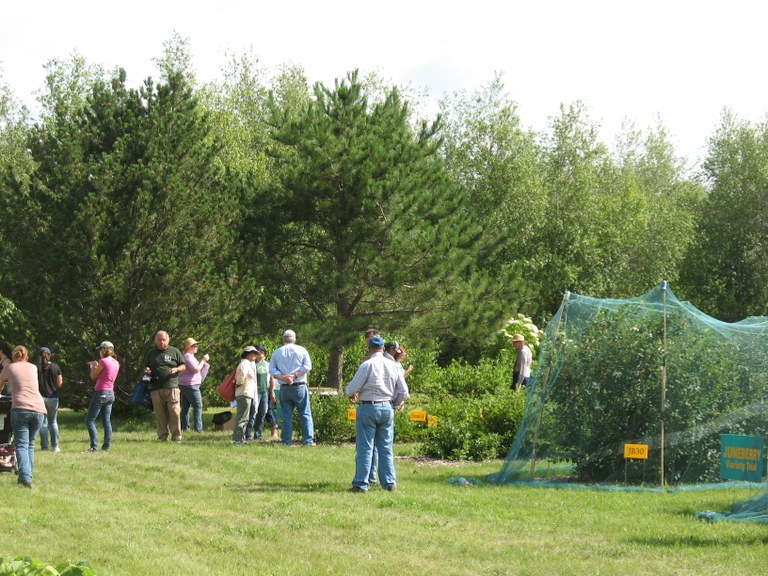
For questions or comments about the 2015 CREC Field Day, please contact mary.berg@ndsu.edu.We hope you enjoyed our photo review!
Crop Tours Highlight Carrington Reserach Extension Center Field Day
The North Dakota State University Carrington Research Extension Center (CREC) annual field day will be held Tuesday, July 14.
Two crop tours will give participants opportunities to view research trials and receive current production information. Crop variety performance and production management, and crop pest and plant nutrition/soil management will be highlighted.
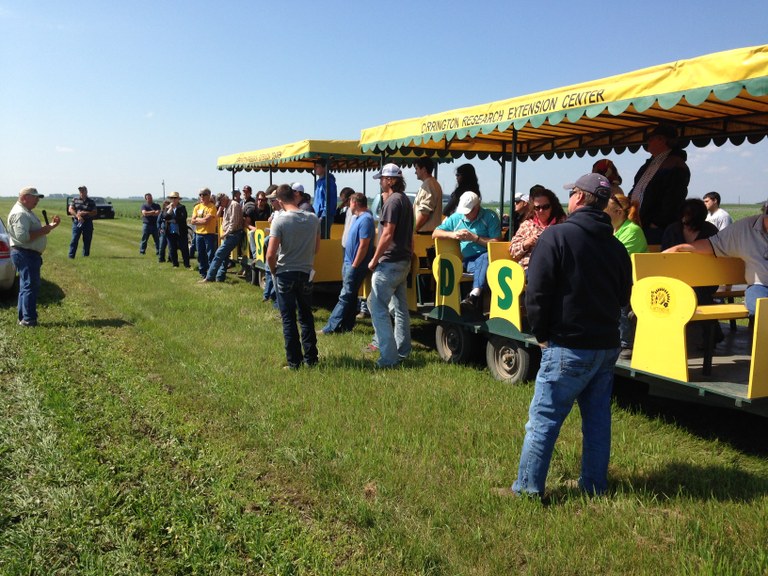
The morning tour will begin at 9:30 a.m. It will include a review of spring and durum wheat, barley and dry bean cultivars by NDSU plant breeders. Greg Endres and Joel Ransom, Extension agronomists will discuss the current status and end-of-season management of corn and soybean. In addition, Blaine Schatz, CREC director and agronomist, will give an update on cool-season legumes with emphasis on field peas.
Following a noon lunch, tour participants may attend a second crop tour starting at 1 p.m. that will focus on two areas:
Crop Pest Management
* Michael Wunsch, CREC plant pathologist, will provide an update on managing white mold (sclerotinia) in soybean and dry bean, and seed treatment in soybean.
* Andrew Friskop, Extension plant pathologist, will review the impact and management of small-grain diseases.
* Richard Zollinger and Kirk Howatt, weed scientists, will review this season's weed management challenges and recommendations.
Plant Nutrition and Soil Management
* John Nowatzki, Extension agricultural machine systems specialist, and Paulo Flores, CREC nutrient management specialist, will lead a discussion on research with unmanned aerial systems.
* Endres, Nowatzki and Ransom will review recommendations and methods for postemergence nitrogen (N) application in corn to increase yield and post- anthesis N application to increase protein in spring wheat.
* Mike Ostlie, CREC research agronomist, will review work with winter rye in soybean for soil protection and weed suppression.
* Jasper Tebow, CREC soil scientist, will highlight research work at the center and recommendations on sulfur management.
In addition to the agronomy tours, field day visitors will have the opportunity to attend fruit, livestock and sustainable agriculture tours.
For more information, contact the CREC at (701) 652-2951 or visit its website at https://www.ag.ndsu.edu/CarringtonREC.
Greg Endres
Area Specialist, Cropping Systems
Organic / Sustainable Ag at CREC Field Day
Organic crop production and sustainable agriculture are the focus of a morning tour and afternoon meeting being held during the North Dakota State University Carrington Research Extension Center’s annual field tours on July 14.
Tour:
This is the Center’s Fourth Annual Organic/Sustainable Ag tour and the 11th year since establishing and managing an organic field at the CREC.
The organic/sustainable agriculture program will begin at 9 a.m. with registration, coffee and a welcome. Steve Zwinger, Research Specialist at the Carrington Research Extension Center, and member of the NPSAS Farmer Breeder Club will lead the tour.
Speakers and their topics include:
- Byron Lannoye and Emily Paul, General manager and Sales representative for Pulse USA – Organic Field Pea Variety Development
- Steve Zwinger, organic/forage researcher at the Carrington center - research summary for the Ancient grains - Spelt, Einkorn, & Emmer
- Frank Kutka, Northern Plains Sustainable Agriculture Society (NPSAS) Farm Breeding Club - Einkorn Accession Evaluation and Development funded by CERES – a non-profit the funds organic research
- Chiwon Lee, NDSU professor of greenhouse production, vegetable culture and breeding- Multistate collaborative vegetable research on cucumbers, onions and green beans
- Mike McMullen, NDSU professor of oat breeding and genetics – Oat Breeding and Variety Performance results
- Tom Rabaey, Agronomist, General Mills – improving Organic Oat Production Research
- Frank Kutka, Northern Plains Sustainable Agriculture Society (NPSAS) Farm Breeding Club - developing cow pea varieties that can be used for seed and cover crops in northern climates. This is a multistate project involving NPSAS, NDSU, South Dakota State University and University of Wisconsin.
- Steve Zwinger – Fingerling potato variety trials – A three year project evaluating ten types of specialty potatoes
- Edd Goerger, Executive Director, NPSAS – Radishes for cover crops project that is funded with a North Central SARE research and education grant
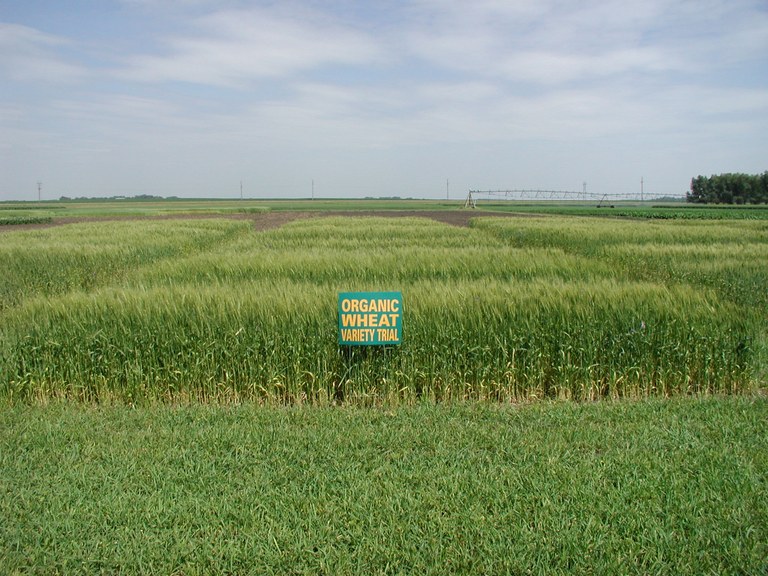
Afternoon Meeting :
Opportunities for Expanding Organic Grain Production in the Northern Great Plains
A presentation from the U.S. Organic Grain Collaboration seeking input from farmers on a strategic plan to increase market opportunities and investments that will help to support the expansion of organic grain production (feed grade and food grade). This session is an opportunity for farmers, seed suppliers, buyers, processors and organic grain consumers to ask questions about the project and share insights about where additional investment is most needed. The collaboration will be represented by Grain Millers, Annie's, Clif Bar, Nature's Path and the Organic Trade Association.
Also, Agronomy, northern-hardy fruit and livestock tours will be held in the morning. The tours will depart at 9:30 and run until noon. An afternoon program on unmanned aerial vehicle use in agriculture will start at 1:30 p.m. An open house and tours of the new Agronomy Laboratory will be available.
For more information about the organic/sustainable ag programs, contact Zwinger or Karl Hoppe at (701) 652-2951 or email Zwinger at steve.zwinger@ndsu.edu or Hoppe at karl.hoppe@ndsu.edu.
Be Our Guest!
On behalf of the scientists, specialists, technicians, summer crew, and support staff at the Carrington Research Extension Center, we invite you to attend our annual Field Day on Tuesday, July 14.
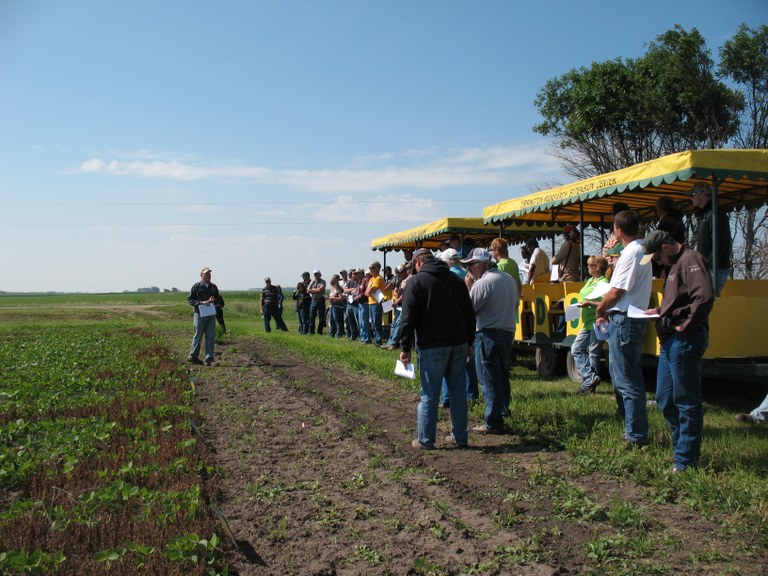
Plan to arrive shortly before 9:00 a.m. Enjoy some coffee or juice and donuts during our brief welcome, and then choose one of four tours in the morning: (1) agronomy, (2) livestock research, (3) organic/sustainable agriculture, and (4) Northern Hardy Fruits. Tours depart the yard at 9:30 a.m.
We’ll take care of the tour wagons, escort you on the tour, and bring you back to the main station for a free noon meal. At 1:00 p.m., another set of agronomy tours will leave the yard to focus on crop pest management, plant nutrition and soil management, while a special guest speaker will share his experiences with small-scale fruit processing and fruit products and marketing inside the main building. Tours and presentations conclude around 3:00 p.m.
Individual presentations will be brief, and illustrative samples are often passed among the tour attendees. While there won’t be time to discuss all of the hundreds of trials underway at the CREC, you will be able to identify many types of crops while on our tour trailers. Trials will have identifying signs, and your tour brochure and map will list our on-station trials.
A few of us will be on the air at Carrington’s local radio station, KDAK 1600AM, on the days leading up to our Field Day. You can listen live at http://www.newsdakota.com/kdak-1600am/ .
- On July 8 (at 8:40 a.m.), Greg Endres will describe the agronomy tour.
- On July 9 (at 8:40 a.m.), Kathy Wiederholt will discuss the Hardy Fruit Tour, followed by Steve Zwinger with information on our organic and sustainable ag tour.
- On July 10 (at 7:30 a.m.), Chanda Engel will provide an overview of our livestock tour.
- On July 13, the day before our Field Day, Linda Schuster will be the air at 7:30 a.m. with general information about Field Day and what to expect when you arrive at CREC.
A full agenda will be posted at https://www.ag.ndsu.edu/carringtonrec/events/crec-field-day .
We are located 3.5 miles north of Carrington on U.S. Highway 281. For more information call us at (701) 652-2951.
Linda Schuster
Administrative Secretary
Sulfur Deficiency in Corn
Corn showing sulfur deficiency in growing areas
Corn sulfur (S) deficiency is a growing problem in and across North Dakota. There is growing awareness that sulfur deficiency is not only limited to sandy soils as it was considered before. Since over 90% of plant available S is present in soil primarily as a constituent of soil organic matter (SOM), soil test results are unreliable and therefore cannot be used to predict sulfur availability to crops during the growing season. A cool spring (cold soils) and prolonged wet soils really slows down microbial activity and breakdown of SOM to release S. Deficiencies are more likely to occur in cool spring no-till crops and poorly drained field areas.
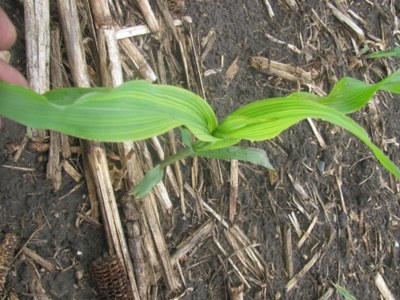
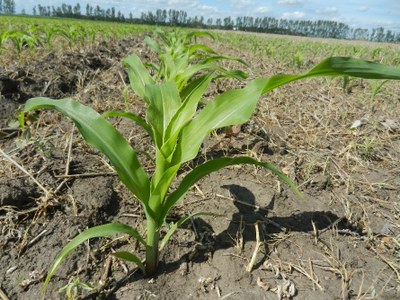
Corrective measures for corn deficiency
Deficient corn plants can be identified if the plants are showing symptoms like the photos above. Young leaves are pale yellow to yellow with the veins remaining green. Collect above-ground whole plants at V4 or the youngest leaf with fully formed collar at V5. Also collect older plants from suspected areas and another set from healthy looking plants in unaffected areas of the field. Submit for complete nutrient analysis to be sure it is S and not another nutrient deficiency with similar symptoms such as zinc and magnesium. If S is recommended from the tissue analysis, consider applying sulfur before the 8th leaf stage at the recommended rates below:
- Apply 50 lbs/acre of ammonium sulfate (21-0-0 + 24S) dry over the top with a granular spreader
or - Apply 3 gal/acre of ammonium thiosulfate (12-0-0-26) to a stream between the corn rows or through the UAN coulter applicator.
- https://www.ag.ndsu.edu/cpr/soils/sulfur-deficiency-in-corn-pandemic-06-18-15
Jasper.Teboh@ndsu.edu
Soil Scientist
Soybean Growth and Development
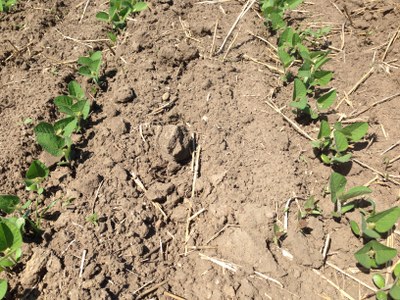 The first is the vegetative stage (V) that starts at emergence and leaf development (Table 1). Currently, most soybean are in the unifoliolate stage (see picture). Soybean plant development has two distinct phases. The second phase in the development is the reproductive (R) stage which starts with flowering, followed by pod development, and ends when the seed is fully mature.
The first is the vegetative stage (V) that starts at emergence and leaf development (Table 1). Currently, most soybean are in the unifoliolate stage (see picture). Soybean plant development has two distinct phases. The second phase in the development is the reproductive (R) stage which starts with flowering, followed by pod development, and ends when the seed is fully mature.
Correct production decisions using plant growth stages are important to optimize yield. Information on the development of the soybean plant and various pictures of all the growth stages can be found in the recently reviewed ‘Soybean Growth and Management Quick Guide,’ an NDSU extension publication (A1174) at www.ag.ndsu.edu/pubs/plantsci/rowcrops/a1174.pdf.
Plant stages are determined by the leaf, flower, pod, and seed development within the pods. A leaf is considered fully developed when the leaf at the node directly above it (the next younger leaf) has expanded enough so that the three leaflets, which make up the ‘trifoliolate leaf’ are fully visible. Leaf development will continue during the reproductive phase and plant stature will still increase. The growth stages can overlap. On a field level a growth stage is reached when at least 50% or more of the plants are in or beyond the respective growth stage.
Flowering of the soybean plant is initiated (after the longest day) on the third to sixth main stem node (a node is a part of the stem where a leaf is attached) and continues upward and downward from there. First flowers are usually present during the first half of July.
The critical growth stage in soybean is from the R4-R6 (late pod development to early seed fill). Plant stress during this period will cause more yield reduction than at another time in the plant’s development. The seed is physiological mature when 95% of the pods on the plant have a mature color (R8 stage).
Greg Endres
Area Specialist, Cropping Systems
Hans Kandel
Extension Agronomist
Field Inspection Deadline
As is true throughout most of North Dakota, small grains are up and looking good. An overall early spring created a positive scenario for this year’s growing season, allowing growers to control planting dates to potentially maximize yields. A drier-than-normal winter left many potholes dry enough to be seeded again. With timely moisture, yields should be above average.
Along with several hundred agronomic trials (each trial consists of 40-360 individual 100-200 square-foot plots), the Carrington Research Extension Center plants several “regular-size” fields to increase production of Foundation-grade seed. We also plant in the spaces surrounding plots to make the most of our limited land-base. Our Seedstocks fields are managed just like those belonging to the surrounding farmers, with a few exceptions. As a major producer of Foundation Seed in the state of North Dakota, we are conditioning boundaries and monitoring our fields carefully, watching for signs of weeds, insects, or disease so we can manage these pressures appropriately.
In addition to recording initial planting dates for crop insurance coverage, another important deadline is approaching for the certified seed growers. Early season crops Field Inspection Applications must be submitted by June 15. The State Seed Department (SSD) encourages early applications to avoid late fees.
Application forms can be obtained through your county agent, by calling the SSD at 701-231-5400 or accessed online at www.ndseed.com. Other important deadlines are on the application forms.
A few key items must be submitted with your application:
- A bulk certificate or seed bag tag for each variety. The lot number for the application will come from the bulk certificate or seed tag lot number.
- A copy of the FSA map with the field boundaries indicated. A five-foot isolation strip, such as a ditch, a fence line or a mown or tilled border, between inseparable crops must be in place before the field inspector arrives.
- Payment of field inspection fees must accompany the signed application. The payment schedule is located on the back of the sheet.
- A cropping history of at least one year. Durum producers must provide a two-year crop history with no wheat on the field. There is enough space for the two year history in the same box.
Below is an appropriate example of a clean field border. I hope you have a good growing season!
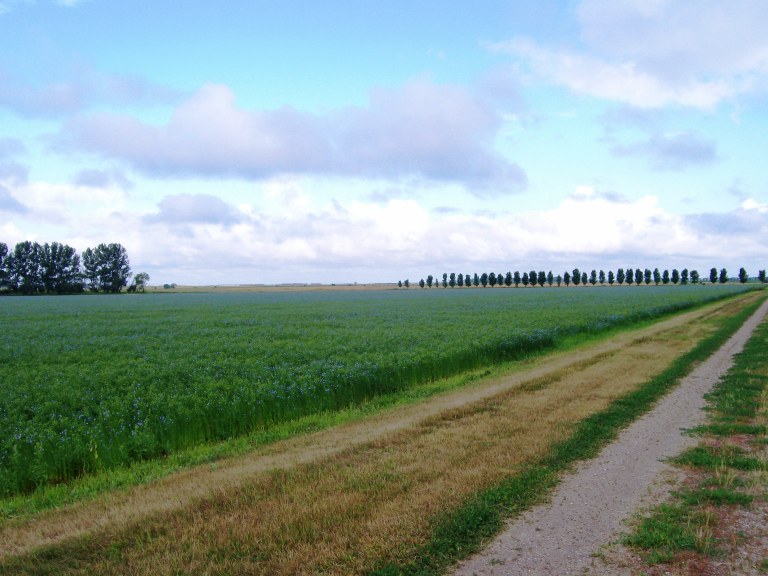
Dave Copenhaver
Foundation Seedstocks Research Spec.


